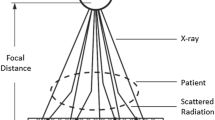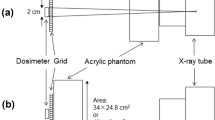Abstract
Our aim in this study was to evaluate the effect of the grid variations on the imaging performance for a computed radiographic system under identical exposure condition. Digital radiographies using a 20-cm Lucite phantom were performed without grid and with grid ratios of 5:1, 8:1, 10:1, 12:1, and 14:1. The scatter fraction, the incident dose to the image receptor, the Wiener spectrum (WS), and the noise-equivalent quanta (NEQ) were measured. Visibility of low-contrast signals was evaluated using a contrast-detail phantom. The scatter fractions decreased considerably with an increase in the grid ratio. On the other hand, the WSs were increased (the noise property deteriorated) as the grid ratio increased due to a decreased incident dose to the image receptor under the identical exposure condition. The NEQs were improved as the grid ratio increased. The high grid ratios provided higher low-contrast detectability compared to the low grid ratios. Our results indicated that the removal of scattered radiation was very effective in improvement of the NEQ in the digital system under the identical exposure condition.






Similar content being viewed by others
References
Higashida Y, Moribe N, Hirata Y, Morita K, Doudanuki S, Sonoda Y, Katsuda N, Hiai Y, Misumi W, Matsumoto M, Yoshioka S, Takahashi M. Computed radiography utilizing laser-stimulated luminescence: detectability of simulated low-contrast radiographic objects. Comput Med Imaging Graph. 1988;12(3):137–45.
Fujita H, Ueda K, Morishita J, Fujikawa T, Ohtsuka A, Sai T. Basic imaging properties of a computed radiographic system with photostimulable phosphors. Med Phys. 1989;16(1):52–9.
Morishita J, Fujita H, Ohtsuka A, Ueda K, Fujikawa T, Yamauchi S, Nishihara S, Hashida M, Kanzaki R, Kanai K, Tanaka S, Nakanishi T. Basic imaging properties in a computed radiography system. Jpn J Radiol Technol. 1990;46(6):824–30. (in Japanese).
Ohtsuka A, Morishita J, Ueda K, Hashida M, Yamauchi S, Murakami S, Takada H, Ohguchi S, Kanai K, Ohmura K, Nakanishi T. Low-scatter radiography using computed radiography: a new concept in improving image quality. Jpn J Radiol Technol. 1991;47(4):610–9. (in Japanese).
Sanada S, Doi K, Xu XW, Yin FF, Giger ML, MacMahon H. Comparison of imaging properties of a computed radiography system and screen-film systems. Med Phys. 1991;18(3):414–20.
Higashida Y, Moribe N, Morita K, Katsuda N, Hatemura M, Takada T, Takahashi M, Yamashita J. Detection of subtle microcalcifications: comparison of computed radiography and screen-film mammography. Radiology. 1992;183(2):483–6.
Kanai K, Ohtsuka A, Hashida M, Yamauchi S, Ueda K, Morishita J, Nishihara S, Kanzaki R, Nakanishi T. Detectability of simulated low-contrast object using computed radiography: differences for incident dose, primary fraction and contrast enhancement. Jpn J Radiol Technol. 1993;49(4):570–5. (in Japanese).
Don S, Hildebolt CF, Sharp TL, Shackelford GD, Lau DM, Herman TE, McAlister WH. Computed radiography versus screen-film radiography: detection of pulmonary edema in a rabbit model that simulates neonatal pulmonary infiltrates. Radiology. 1999;213(2):455–60.
Aufrichtig R. Comparison of low contrast detectability between a digital amorphous silicon and a screen-film based imaging system for thoracic radiography. Med Phys. 1999;26(7):1349–58.
Rong XJ, Shaw CC, Liu X, Lemacks MR, Thompson SK. Comparison of an amorphous silicon/cesium iodide flat-panel digital chest radiography system with screen/film and computed radiography systems—a contrast-detail phantom study. Med Phys. 2001;28(11):2328–35.
Ludwig K, Lenzen H, Kamm KF, Link TM, Diederich S, Wormanns D, Heindel W. Performance of a flat-panel detector in detecting artificial bone lesions: comparison with conventional screen-film and storage-phosphor radiography. Radiology. 2002;222(2):453–9.
Ludwig K, Henschel A, Bernhardt TM, Lenzen H, Wormanns D, Diederich S, Heindel W. Performance of a flat-panel detector in the detection of artificial erosive changes: comparison with conventional screen-film and storage-phosphor radiography. Eur Radiol. 2003;13(6):1316–23.
Uffmann M, Schaefer-Prokop C. Digital radiography: the balance between image quality and required radiation dose. Eur J Radiol. 2009;72(2):202–8.
Utsumi H, Otsuka A, Nakanishi T, Yokoyama T, Higashida Y. A systematic study on factors affecting patient dose (3rd report: on grid and Bucky factor). Jpn J Radiol Technol. 1979;35(3):331–7. (in Japanese).
Chan HP, Doi K. Investigation of the performance of antiscatter grids: Monte Carlo simulation studies. Phys Med Biol. 1982;27(6):785–803.
Chan HP, Doi K. Physical characteristics of scattered radiation and the performance of antiscatter grids in diagnostic radiology. Radiographics. 1982;2(3):378–406.
Doi K, Frank PH, Chan HP, Vyborny CJ, Makino S, Iida N, Carlin M. Physical and clinical evaluation of new high-strip-density radiographic grids. Radiology. 1983;147(2):575–82.
Chan HP, Frank PH, Doi K, Iida N, Higashida Y. Ultra-high-strip-density radiographic grids: a new antiscatter technique for mammography. Radiology. 1985;154(3):807–15.
Chan HP, Higashida Y, Doi K. Performance of antiscatter grids in diagnostic radiology: experimental measurements and Monte Carlo simulation studies. Med Phys. 1985;12(4):449–54.
Chan HP, Lam KL, Wu YZ. Studies of performance of antiscatter grids in digital radiography: effect on signal-to-noise ratio. Med Phys. 1990;17(4):655–64.
Wamser GR, Aichinger H, Maier W, Bohndorf K. Clinical evaluation of a new stationary high strip density antiscatter grid in comparison with a conventional moving grid: influence on image quality and patient radiation dose. Eur Radiol. 2001;11(9):1710–9.
Boone JM, Seibert JA, Tang CM, Lane SM. Grid and slot scan scatter reduction in mammography: comparison by using Monte Carlo techniques. Radiology. 2002;222(2):519–27.
Shen SZ, Bloomquist AK, Mawdsley GE, Yaffe MJ, Elbakri I. Effect of scatter and an antiscatter grid on the performance of a slot-scanning digital mammography system. Med Phys. 2006;33(4):1108–15.
Gennaro G, Katz L, Souchay H, Klausz R, Alberelli C, di Maggio C. Grid removal and impact on population dose in full-field digital mammography. Med Phys. 2007;34(2):547–55.
Kanai K, Ohtsuka A, Morishita J, Yamauchi S, Ueda K, Nishihara S, Tanaka S, Nakanishi T. Comparison of measurement methods of characteristic curves for digital subtraction angiography (DSA) systems. Jpn J Radiol Technol. 1988;44(10):1492–6. (in Japanese).
Morishita J, Fujita H, Sakamoto K, Ueda K, Ohtsuka A, Fujikawa T, Yamauchi S, Kamakura T, Tanaka S. Measurements of characteristic curves in a computed radiographic system (II). Med Imag Inf Sci. 1989;6(1):25–33. (in Japanese).
Inatsu H, Ueda M, Azuma T, Mitarai A, Arita H. Relation between the position of lead disks and measured values of the scatter fraction for the disk method. Jpn J Radiol Technol. 1991;47(5):709–13. (in Japanese).
Giger ML, Doi K, Metz CE. Investigation of basic imaging properties in digital radiography. 2. Noise Wiener spectrum. Med Phys. 1984;11(6):797–805.
Dobbins JT 3rd, Samei E, Ranger NT, Chen Y. Intercomparison of methods for image quality characterization. II. Noise power spectrum. Med Phys. 2006;33(5):1466–75.
Asahara M. Physical image quality assessment in digital radiography: noise power spectrum. Jpn J Radiol Technol. 2009;65(12):1671–9. (in Japanese).
Zhou Z, Gao F, Zhao H, Zhang L. Techniques to improve the accuracy of noise power spectrum measurements in digital x-ray imaging based on background trends removal. Med Phys. 2011;38(3):1600–10.
Kodera Y. Basic thinking of image analysis: detective quantum efficiency (DQE) and noise-equivalent number of quanta (NEQ). Jpn J Radiol Technol. 2010;66(8):958–66. (in Japanese).
Higashide R, Ichikawa K, Kunitomo H, Sawada M. Proposal and verification of presampled MTF measurement by the simple analysis method using edge method. Jpn J Radiol Technol. 2008;64(4):417–25. (in Japanese).
Higashide R, Ichikawa K, Kunitomo H, Ohashi K, Kawano M. Influence of angle-measurement error on pre-sampled MTF and proposal of an optimal technique of angle measurement. Jpn J Radiol Technol. 2009;65(2):245–53. (in Japanese).
Higashide R. Physical image quality assessment in digital radiography: modulation transfer function-edge method. Jpn J Radiol Technol. 2009;65(10):1449–56. (in Japanese).
Thijssen MAO, Bijkerk KR, van der Burght RJM. Manual: contrast-detail phantom artinis CDRAD type 2.0. University Medical Center Nijmegen, 1998.
Bijkerk KR, Thijssen MAO, Arnoldussen ThJM. Manual CDMAM-phantom type 3.4. University Medical Center Nijmegen, St. Radboud, 2001.
Higashida Y, Baba Y, Hatemura M, Yoshida A, Takada T, Takahashi M. Physical and clinical evaluation of a 2,048 × 2,048-matrix image intensifier TV digital imaging system in bone radiography. Acad Radiol. 1996;3(10):842–8.
Kyprianou IS, Rudin S, Bednarek DR, Hoffmann KR. Generalizing the MTF and DQE to include x-ray scatter and focal spot unsharpness: application to a new microangiographic system. Med Phys. 2005;32(2):613–26.
Boyce SJ, Samei E. Imaging properties of digital magnification radiography. Med Phys. 2006;33(4):984–96.
Samei E, Ranger NT, MacKenzie A, Honey ID, Dobbins JT 3rd, Ravin CE. Effective DQE (eDQE) and speed of digital radiographic systems: an experimental methodology. Med Phys. 2009;36(8):3806–17.
Tanaka N, Naka K, Fukushima H, Morishita J, Toyofuku F, Ohki M, Higashida Y. Digital magnification mammography with matched incident exposure: physical imaging properties and detectability of simulated microcalcifications. Radiol Phys Technol. 2011;4(2):156–63.
Acknowledgments
We are grateful to Hidetaka Arimura, PhD, and Seiji Kumazawa, PhD, Department of Health Sciences, Faculty of Medical Sciences, Kyushu University, and Hiroyuki Kuroyanagi, MSc, Fujifilm Medical Corporation, for useful discussions; and to former graduate students of Kyushu University, for participating in this study as observers. The authors wish to express their gratitude to the Japanese Society of Radiological Technology for use of the Excel format for measurements of presampled MTF and WS. We thank the editorial assistant of this journal, Mrs. Elisabeth Lanzl, for providing initial and final polishing of the submitted manuscript in improving the readability and English expressions, and the editors and reviewers for giving us useful comments and suggestions for improving our manuscript.
Author information
Authors and Affiliations
Corresponding author
About this article
Cite this article
Tanaka, N., Naka, K., Saito, A. et al. Investigation of optimum anti-scatter grid selection for digital radiography: physical imaging properties and detectability of low-contrast signals. Radiol Phys Technol 6, 54–60 (2013). https://doi.org/10.1007/s12194-012-0169-y
Received:
Revised:
Accepted:
Published:
Issue Date:
DOI: https://doi.org/10.1007/s12194-012-0169-y




